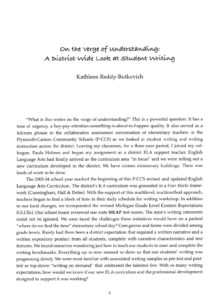On the Verge of Understanding: A District-Wide Look at Student Writing
Excerpt
Rather than beginning with all the extenuating circumstances, we placed student work squarely in front of us. Rather than selecting and sorting the ‘good, the bad, and the ugly’ pieces, we looked at all the students’ texts with the same set of questions. Rather than spending time with our writing laments about missing conventions and lack of details, we focused on finding what was there by describing what we saw in the work and citing evidence in the student texts. Articulating these discoveries, no matter how small, provided the nudge we needed. It is essential for us to see our teaching, our writing curriculum in the students’ work. What teachers do makes a difference in how much our students are capable of achieving as writers. This pushed us to find some answers for the last important round of questions. ‘What are the implications for teaching and learning?’
Based on what we saw in student writing, we brainstormed some next steps for our daily teaching practice. For example, fourth grade teachers read the collected student fantasies. They noticed a variety of dialogue tags—whispered, sneered, demanded, etc. in the students’ pieces, many fourth graders seemed to be on the verge of understanding paragraphing when using dialogue, and one of the implications for teaching included teaching students how to use dialogue to develop plot and characters.


